
A geriatric horse is an equine that has a physical and mental decline, which generally prevents it from being used for most equestrian activities. The age of a geriatric horse could vary according to breed and riding use, with old age occurring more rapidly in Thoroughbred sport horses than in hardy ponies. Geriatric horse signs include tooth eruption, whitening of certain areas of the head, arching of the back and stiffness of locomotion. The animal also becomes more sensitive to the passing of the seasons.
From the 18th and 19th centuries onwards, the practice of hippophagy was no longer a religious prohibition in Europe, and older animals were sold to knackers or slaughtered for their meat. The gradual acquisition of pet status has led to other retirement options for these animals at the end of their lives. Retirements are more frequent, and geriatric horses can also be oriented towards gentle activities such as riding. A geriatric horse can pose an economic and ethical problem, as owners don't always anticipate their animal's longevity or the cost of maintaining it over the long term. This problem is at the root of frauds and swindles involving resale at the slaughterhouse.
Longevity
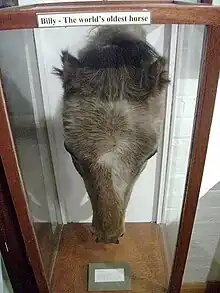
The life expectancy of the domesticated horse has increased thanks to better management of its diet and care,[1] and a growing attachment to the animal.[2] The average longevity of a horse is now between 25 and 30 years,[1] with differences depending on breed and occupation. Ponies enjoy a significantly longer lifespan than horses, often exceeding 30 years old.[3][4] Draft horses, Arabian and Iberian breeds live significantly longer than trotters and Thoroughbreds.[5]
Pierre Enoff claims that horses can live up to 50 years in the wild,[6] a claim contradicted by studies of prehistoric equine bones, which show that they never exceed 15 to 20 years.[7] Wild horses are subject to a variety of pressures that induce high mortality (hunger, thirst, predator attacks, etc.).
The oldest known horse, Old Billy (1760-1822), died at the age of 62 and made the headlines in Manchester. He was a working horse of the Shire/Cob type.[8] Longevity records are regularly reported for horses reaching 37 years (such as Bayou, a French horse of unknown origin[9]), 42 years (such as Tango Duke, 1935-1978, an Australian Thoroughbred record-holder for this breed[10]) or 51 years (such as Badger, a Welsh/Arabian cross, 1953-2004; and Shayne, an Irish Trait,[11] 1962-2013). The pony record belongs to Sancho, another Welsh/Arabian cross who died at 54, in 2003.[12] It was previously held by Steady Teddy, an American pony who died at 53.[13]
The age of death is only a subjective measure,[14] which depends on different factors including diet, genetic inheritance, basic care and environment. In 2000, depending on the specialist, the age of a ‘geriatric horse’ could be 16, 18 or 20.[15] According to William Martin-Rosset, after 3 years, a horse's age can be multiplied by three to obtain a human equivalent. A 20-year-old horse would therefore be roughly equivalent to a 60-year-old human.[14] In the past, a horse was often considered ‘geriatric’ after 15 years,[3] but it is now common for animals over 15 to be actively working. Although the age at which a horse becomes ‘geriatric’ is difficult to establish, veterinarians note that around 70 % of horses over the age of 20 require special care.[16] Exceptions still exist, as some horses aged 25 and over can still be ridden and fed in the same way as any other. The classification of a geriatric horse depends on the occurrence of a health problem (typically osteoarthritis) and outward signs of aging, rather than on its age per se.[14][17] Exceptionally, geriatric horses can remain competitive at high levels in particularly selective events. Nobby became world endurance champion at the age of 16.[3]
Signs of geriatric horses
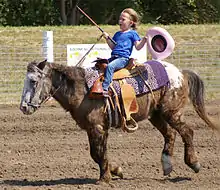
There are certain unmistakable signs of a geriatric horse. Determining a horse's age through observation was of vital importance at a time when horses were used for all aspects of daily life. For example, Le Nouveau Parfait Maréchal (18th century) recommends that to assess the animal age, it could be observed: the teeth, tail, forelock (hollow in old horses[18]), lower jaw (more pronounced in geriatric horses) and white eyebrow hairs, among other things. Historically, horses between 5 and 8 years old were the most expensive, with the value of the animal gradually decreasing after 8 years.[15] The presence of an almost white coat color, rare in young horses, was thus a clue to recognizing a horse over 8 years old.
The back tends to arch, the withers and pelvic bones become more visible,[14] and movements become stiffer as the horse gets older. Poor physical condition (thinness and/or round belly), lack of muscle and very sloping pasterns due to aging tendons and ligaments are all signs of a geriatric horse.[18] The changes are not only physical, as the animal changes its eating habits and reactions to the environment, becoming indifferent to its fellow creatures and to human beings.[14] Its whole rhythm of life slows down, it sleeps more and conserves its energy to resist climate and disease.[19] Most of the signs of a geriatric horse that prevent it from being used to its full potential occur between the ages of 16 and 20. The most disabling and most frequent is a loss of locomotion, often a sign of osteoarthritis.[18][20] In addition to the visible signs, the horse's five senses and its organs, including the respiratory, digestive and cardiovascular systems, also deteriorate.[3]
Mouth and teeth
The horse's mouth and teeth are well known to change with age. The canines become dull, worn and yellow under the action of the bite. Teeth also appear longer and gaunt around the gums and claw incisors come forward[18] as they emerge from the mouth almost horizontally. The palate becomes gaunt, and the grooves fade in geriatric horses. It used to be a popular belief that you could tell a horse's age by pushing out its lip and counting the creases, then the number of them supposedly being equal to its age. More scientifically, the lower lip of geriatric horses can be seen to sag.[18] The observation of teeth is the most reliable criterion for assessing age in the absence of identification documents, and is the origin of the popular expression "don't look a gift horse in the mouth".[21] However, it becomes difficult to estimate a horse's age from its teeth if it is more than 15 years old.[3]
Coat
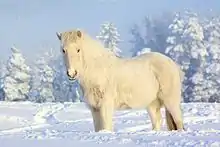
The presence of white hair on the head (around the eyes and muzzle) and sometimes on the body,[14] reminiscent of the whitening of human hair, is another geriatric horse sign, as is the rougher feel of the hair.[18] A dark horse with white eyebrow hair is usually over 15 years old. Older horses sometimes grow winter hair unusually abundantly, early or slowly.[18][22]
Management
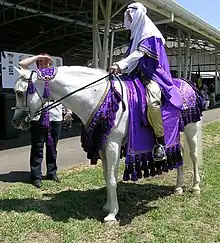
The question of how to manage older horses arises in the context of the horse's rapprochement with the pet and the proliferation of family leisure animals, particularly in Europe and the United States.[23] In the past, the resale of a horse for slaughter or its exploitation up to the point of knackering did not raise ethical or sentimental questions, as the horse had to prove profitable for its owner.[14][24] Since the 1990s, it has become more common to offer retirement to horses at the end of their careers, either with their owner or in a specialized center.[1][22][25] The population of older and/or retired horses is difficult to quantify,[26] but the University of Nevada in Reno, estimates that 10 % of the US horse population is over 20 years old.[15]
Just like any other horse, they should be provided with plenty of water, pasture shelter and a mineral lick,[27] but geriatric horses require precautions that are sometimes overlooked.[28] In addition to keeping an eye on its food, it is strongly recommended to continue vaccinations, teeth maintenance (the equine dentist should be consulted at least once a year, according to veterinarians[17]), deworming[29] and farriery (25 to 50 % of annual costs according to American veterinarians[30]) without isolating the animal, to enable him to end its life in good conditions.[2][14] Geriatric horses frequently suffer from osteoarthritis, and dental and digestive problems. They become more sensitive to the passing of the seasons and can suffer significant weight loss.[31][32]
Retirement

Horses are retired from a wide variety of activities, including riding halls, sport (show jumping, dressage, etc.), showmanship, the army and laboratory research.[33] Racehorses typically have several activities in their lives, as racing is highly selective.[34] A classic solution is to limit older horses to 'riding'. In the United States, these animals are often kept in the family for the instruction of young children.[2] There are also therapeutic riding centers in the U.S., which take in geriatric horses free of charge from private owners to saddle up the disabled.[35] Other geriatric horses are sent to riding schools to teach riding to beginners, but there always comes a time when the animal can no longer be ridden at all. Reduced activity results in a loss of muscle mass, which is aggravated by age. It is not advisable to leave older horses in total inactivity, as this weakens their muscles and skeleton. It is also not advisable to suddenly switch from intense physical activity to rest, as horses adapt better physically and mentally to gradual reductions in activity. Similarly, a horse used to living in a stall cannot adapt overnight to life outdoors. Regular exercise keeps geriatric horses active and useful.[36][37]
There are a number of accommodation centers for retired equines, comparable to 'retirement homes' for horses. In France, the oldest and one of the best-known is Pech Petit, in the Lot region, founded in July 1970 whose objective is to shelter geriatric horses destined for slaughterhouses.[38] Many other similar organizations exist in other countries, including France, Canada, Belgium and Switzerland.[39] Some individuals may decide to leave their horse for economic, family (divorce, death...) or even psychological reasons, to avoid seeing their animal age and having to make the decision to euthanize it.[34] Boarding and retirement services for older horses are set to expand.[40]
Feed

A geriatric horse's diet should be well-balanced, easy to chew and digest, with a preference for semi-dried silage, high-quality hay,[27][41] wheat bran, linseed,[27] flakes or mueslis. High levels of fiber and straw are not recommended, nor is too much alfalfa[42] or apples, which are laxative in high doses.[27] The Institut national de la recherche agronomique (National Institute of Agricultural Research, INRA by its acronym in French) recommends 10-12 % dry matter nitrogen.[27] Pasture is generally not enough to achieve a balanced diet, and supplements are required.[42] Manufacturers are increasingly offering rations adapted to geriatric horses, whose energy needs are decreasing,[17][43] while their mineral requirements seem to be increasing.[37] They feel less hunger and thirst.[44]
Their teeth may be badly worn, or suffer from malocclusion and periodontitis, preventing them from chewing properly.[2][20] In such cases, hay should be chopped before feeding.[27] Digestion can become less efficient, with intestinal transit slowing or even stopping, as evidenced by the horse's droppings.[14][45] Geriatric horses drink less often, leading in extreme cases to dehydration.[14] If the liver and kidneys are impaired, urine becomes dark and foul-smelling.[37]
Geriatric horses tend to lose weight and body fat,[14] which may mean they need to be given larger quantities of feed or a higher-quality ration.[2] Weight loss is frequent, and can have multiple causes (deficiencies, dental problems, lack of appetite, digestive problems, etc.[46]), making mortality more likely. It's tricky to get a geriatric horse to put on weight again,[32] but one possibility is to add vegetable fat (such as corn oil) to their feed.[47] This problem of weight loss can cause problems for owners, who are sometimes wrongly suspected of animal abuse.[28] The opposite problem also exists: overfed, inactive horses can become obese, damaging their legs and hooves.[2]
Pasturing
In the case of group feeding, geriatric horses may not be able to resolve dominance issues with their pasture mates and may be denied access to food.[2] Geriatric horses should be kept in pairs if they get on well, rather than in a herd.[48] Two geriatric horses sharing the same meadow or paddock often develop strong bonds of friendship. However, if they are separated, or if one of them dies, the separation can cause the animal left alone to wither away.[19]
Health

A typical disease in geriatric horses is Cushing's disease, caused by an increase in cortisone in the blood. It can be detected by a shaggy coat, perspiration and excessive urination. Without a cure, however, the disease can be controlled. The closely related Equine Metabolic Syndrome (EMS) is another typical disease causing obesity and laminitis. Carbohydrate restriction and exercise can alleviate the condition.[49]
The risk of colic increases with age, with geriatric horses statistically more prone to surgical colic. The absence of sustained activity reduces this risk, as do pasturing[50] and deworming.[51] Osteoarthritis, the damage of articular cartilage with phases of crisis and remission, causes great suffering in geriatric horses. It is a major cause of horse euthanasia.[52][53] Age alters the structure of the cartilage and increases the severity of the condition, which becomes more serious in the absence of appropriate hoof care.[54] Pain can be relieved by administering an anti-inflammatory.[55] It is also advisable to walk and trot the animal to raise muscle temperature and activate blood circulation.[36] However, very geriatric horses may become unable to stand or lie down on their own.[22] The hooves are more fragile, with a greater risk of laminitis.[52]
Geriatric horses may also suffer from osteoporosis and eyesight problems, leading to special needs, and a general lowering of immunity to disease.[18] When they injure themselves, infectious complications are more frequent.[14]
Mortality

It's very rare for a horse to actually die of old age: a survey of French-speaking veterinarians in 1997 found only 0.6 % of cases.[56] The leading cause of death is colic. Other causes of death in horses over fifteen years of age include locomotion disorders (osteoarthritis, fractures), disorders of the reproductive system,[4] cardiac arrest and failure,[57] respiratory disorders and tumors or cancers of all kinds.[4] Colic is aggravated in geriatric horses by fatty tumors, pedunculated lipomas, which cause torsion and obstruction during digestion. Mortality due to diseases of the reproductive system is generally caused by late breeding, resulting in rupture of the uterine artery during parturition. Cancers, lymphomas and tumors are becoming a major cause of mortality in geriatric horses. Infectious diseases account for only 10-15 % of deaths.[58] Cardiac arrest is typical of older sport horses,[59] while respiratory ailments (pulmonary emphysema, etc.) mainly affect horses retired from riding halls.[60] In most countries, dead horses are still sent to knackers, but the idea of horse cemeteries is increasing.[25]
Economic aspects

Managing horses at the end of their lives raises economic issues.[61] In 1990, sociologist and demographer Vérène Chevalier spoke out against the retirement of horses, arguing that it damages the economy of the entire equine industry, pushing owners to spend their money on maintaining a useless horse instead of buying a new one and sending the old one to the slaughterhouse.[62][63] Similarly, the High Council for Food, Agriculture and Rural Areas (Conseil général de l'alimentation, de l'agriculture et des espaces ruraux, CGAAER[64] by its acronym in French) and the INRA believe that knackery should be reduced and slaughtering increased, as retiring geriatric horses would mean “wasting” a “significant proportion of the availability of quality red meat”. The emotional bond between rider and horse is seen as a “brake” on slaughter.[65]
Cost
A geriatric horse can become impossible to sell, and expensive to manage. The classic example is the horse that is not allowed to be resold in the horse-breeding industry, and has no commercial value. For owners wishing to keep their animals out of slaughterhouses, the cost of maintaining them and paying the knacker must be taken into account.[28][35] Some geriatric horses suffering from ailments or illnesses such as colic are not treated for economic reasons.[50] Owners who can no longer afford to maintain their horse can entrust it to a charity.[35][33]
Frauds and scams
The existence of frauds and scams involving old horses is well known. They involve various organizations and individuals who, under the guise of being charities and offering horses a happy retirement, actually seek to obtain animals free of charge, which they then resell to a slaughterhouse, pocketing the profit corresponding to the price of the meat.[28][66][67] In the USA, some unscrupulous therapeutic riding centers euthanize horses that are too old to be ridden, or sell them to the slaughterhouse.[35] This scam has grown with the economic crisis.[68] Documented since 2011[69] and suspected since at least the beginning of 2013 in France, this ‘retirement fraud’ was publicly revealed at the end of August, after the discovery of falsified identification papers for equidae in Belgium,[66] posing a health risk to consumers.[70] It highlighted major differences of opinion between the various players in the horse world and the breeding institutions representing them. The French National Horse Federation was quick to defend the horsemeat industry.[71] In response, France has tightened regulations on horse slaughter, making it compulsory to present the animal's medication record.[61]
In culture
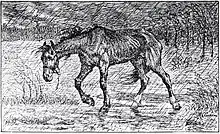
Old horses are mentioned in a number of works, including Nils Holgersson's The Wonderful Adventures of Nils[72] and Animal Farm, where the draft horse Malabar, exhausted from building a mill, is the victim of the greed of pigs who pretend to send him to hospital, but actually sell him to the knacker's yard to buy a case of whisky. In The Three Musketeers, Alexandre Dumas refers to D'Artagnan's mount as a 13-year-old horse. His father entrusts it to him, along with a letter recommending that he never sell the animal, but rather let it die quietly and honorably of old age. However, D'Artagnan, disgraced in Paris by such a horse, prefers to sell it for three écus.[73] In the children's book Le Vieux Cheval et la Mer, two children allow their oldest horse to see the sea one last time.[74]
Geriatric horses can play a more valorizing role in storytelling. In the Wolof oral tale Le Cheval enchanté, the horse Samba Bingi Bangi, "older than God himself", saves the life of the young girl to whom it is given as a wedding present. The imprudent girl has married a lion against her will. Samba Bingi Bangi gives its life to save her from the trap.[75]
In cinema, Béla Tarr's The Turin Horse, released in 2011, opens with a vision of an old coachman and his horse, inspired by an episode in the life of Friedrich Nietzsche who, in 1889, embraced an old carriage horse in Turin before giving in to madness. The film tells the story of this horse before his encounter with Nietzsche.[76] The French film Heureux qui comme Ulysse, starring Fernandel, tells the story of a 28-year-old Camargue horse destined to die in the arena. However, Antonin (Fernandel) sets him free in the Camargue.
See also
References
- 1 2 3 Corbin, Christelle (2001). Pathologie du vieux cheval : étude d'une population de chevaux en retraite à Pech Petit (in French). École nationale vétérinaire de Lyon. p. 3.
- 1 2 3 4 5 6 7 Connally, Bruce. "Managing the geriatric horse". Colorado State University. p. 1. Retrieved 23 April 2014.
- 1 2 3 4 5 Laurent (2011)
- 1 2 3 Corbin, Christelle (2001). Pathologie du vieux cheval : étude d'une population de chevaux en retraite à Pech Petit (in French). École nationale vétérinaire de Lyon. p. 9.
- ↑ Corbin, Christelle (2001). Pathologie du vieux cheval : étude d'une population de chevaux en retraite à Pech Petit (in French). École nationale vétérinaire de Lyon. pp. 42–43.
- ↑ Enoff, Pierre (2009). "Le désespoir des chevaux ! L'espérance de vie et la longévité du cheval". Planète Cheval au Naturel (in French).
- ↑ Bignon, Olivier (2008). Chasser les chevaux à la fin du Paléolithique dans le Bassin parisien : stratégie cynégétique et mode de vie au Magdalénien et à l'Azilien ancien (in French). Oxford: Archaeopress. p. 169. ISBN 978-1-4073-0189-1.
- ↑ Seyd, Edmund (1973). Old Billy, 1760-1822 : The World's Oldest Horse. Manchester Museum. p. 12. ISBN 0-904630-01-3.
- ↑ "À 37 ans, Bayou le cheval défie le record de longévité". Le Dauphiné.com. 2012. Retrieved 21 April 2014.
- ↑ Matthews, Peter (1995). The Guinness Book of Records. Guinness Superlatives. p. 31.
- ↑ Molnar, Lazlo (2012). "A 51 ans, « Shayne » est le plus vieux cheval en vie". Le Matin (in French). Retrieved 22 April 2014.
- ↑ Folkard; Guinness World Records Limited; Masson; Freshfield; Dimery (2004). Guinness world records 2005. Guinness World Records Ltd. p. 73. ISBN 0-85112-192-6.
- ↑ The Guinness Book of Records. 1996. p. 27.
- 1 2 3 4 5 6 7 8 9 10 11 12 Martin-Rosset (2012, p. 312)
- 1 2 3 Cirelli, Al. (2000). "Care Of The Geriatric Horse". University of Nevada.
- ↑ Gibbs et al., p. 2)
- 1 2 3 Gibbs et al., p. 2)
- 1 2 3 4 5 6 7 8 Cirelli, Al. (2000). "Care Of The Geriatric Horse". University of Nevada: 2.
- 1 2 Deutsch, Julie (2006). Le comportement du cheval. Les Équiguides (in French). éditions Artemis. p. 127. ISBN 2-84416-640-7.
- 1 2 Couroucé-Malblanc (2010, p. 294)
- ↑ Carius, Manuel (2005). Le droit du cheval et de l'équitation (in French). Paris: France Agricole Éditions. p. 238. ISBN 2-85557-127-8.
- 1 2 3 Gibbs et al., p. 12)
- ↑ Digard (2007, p. 187)
- ↑ Corbin, Christelle (2001). Pathologie du vieux cheval : étude d'une population de chevaux en retraite à Pech Petit (in French). École nationale vétérinaire de Lyon. p. 41.
- 1 2 Digard (2007, p. 186)
- ↑ Corbin, Christelle (2001). Pathologie du vieux cheval : étude d'une population de chevaux en retraite à Pech Petit (in French). École nationale vétérinaire de Lyon. p. 74.
- 1 2 3 4 5 6 Martin-Rosset (2012, p. 314)
- 1 2 3 4 Valren (2014)
- ↑ Gibbs et al., p. 8-9)
- ↑ Gibbs et al., p. 7-8)
- ↑ Ralston, Sarah. "Management of geriatric horses". Cook College, Rutgers University.
- 1 2 Gibbs et al., p. 4)
- 1 2 Corbin, Christelle (2001). Pathologie du vieux cheval : étude d'une population de chevaux en retraite à Pech Petit (in French). École nationale vétérinaire de Lyon. p. 40.
- 1 2 Corbin, Christelle (2001). Pathologie du vieux cheval : étude d'une population de chevaux en retraite à Pech Petit (in French). École nationale vétérinaire de Lyon. p. 45.
- 1 2 3 4 Pavia, Audrey; Posnikoff, Janice; D.V.M. (2005). Horses For Dummies. For dummies (2nd ed.). John Wiley & Sons. p. 230. ISBN 0-471-78124-X.
- 1 2 Gibbs et al., p. 6-7)
- 1 2 3 Martin-Rosset (2012, p. 313)
- ↑ Corbin, Christelle (2001). Pathologie du vieux cheval : étude d'une population de chevaux en retraite à Pech Petit (in French). École nationale vétérinaire de Lyon. p. 30.
- ↑ ""Centres de retraite pour chevaux" : 31 sites enregistrés". Equids (in French). Retrieved 19 May 2015.
- ↑ Dornier et al. (2015, p. 6)
- ↑ Corbin, Christelle (2001). Pathologie du vieux cheval : étude d'une population de chevaux en retraite à Pech Petit (in French). École nationale vétérinaire de Lyon. p. 11.
- 1 2 Cirelli, Al. (2000). "Care Of The Geriatric Horse". University of Nevada: 3.
- ↑ Ralston, Sarah. "Management of geriatric horses". Cook College, Rutgers University: 394.
- ↑ Wolter (1999, p. 407)
- ↑ Wolter (1999, p. 409)
- ↑ Couroucé-Malblanc (2010, p. 296)
- ↑ Gibbs et al., p. 5)
- ↑ Lambert-Lefranc & Laurent (2011)
- ↑ Connally, Bruce. "Managing the geriatric horse". Colorado State University: 2.
- 1 2 Corbin, Christelle (2001). Pathologie du vieux cheval : étude d'une population de chevaux en retraite à Pech Petit (in French). École nationale vétérinaire de Lyon. pp. 24–25.
- ↑ Corbin, Christelle (2001). Pathologie du vieux cheval : étude d'une population de chevaux en retraite à Pech Petit (in French). École nationale vétérinaire de Lyon. pp. 26–27.
- 1 2 Couroucé-Malblanc (2010, p. 300)
- ↑ Corbin, Christelle (2001). Pathologie du vieux cheval : étude d'une population de chevaux en retraite à Pech Petit (in French). École nationale vétérinaire de Lyon. p. 14.
- ↑ Corbin, Christelle (2001). Pathologie du vieux cheval : étude d'une population de chevaux en retraite à Pech Petit (in French). École nationale vétérinaire de Lyon. pp. 16–20.
- ↑ Ralston, Sarah. "Management of geriatric horses". Cook College, Rutgers University: 395.
- ↑ Corbin, Christelle (2001). Pathologie du vieux cheval : étude d'une population de chevaux en retraite à Pech Petit (in French). École nationale vétérinaire de Lyon. p. 8.
- ↑ Wolter (1999, p. 413)
- ↑ Corbin, Christelle (2001). Pathologie du vieux cheval : étude d'une population de chevaux en retraite à Pech Petit (in French). École nationale vétérinaire de Lyon. p. 10.
- ↑ Corbin, Christelle (2001). Pathologie du vieux cheval : étude d'une population de chevaux en retraite à Pech Petit (in French). École nationale vétérinaire de Lyon. p. 76.
- ↑ Corbin, Christelle (2001). Pathologie du vieux cheval : étude d'une population de chevaux en retraite à Pech Petit (in French). École nationale vétérinaire de Lyon. p. 78.
- 1 2 Dornier et al. (2015, p. 1)
- ↑ Chevalier, V. (1990). "Les pratiquants de l'équitation : une population et ses mouvements". Population. 45 (3): 661–666. doi:10.2307/1533543. JSTOR 1533543.
- ↑ Digard, Jean-Pierre (1993). "Cheval, mon amour". Des sports (in French). Éditions MSH. pp. 59–60. ISBN 9782110889287.
- ↑ Valren, Amélie (2015). "Fin de vie du cheval : un rapport sort de l'ombre…". Cheval Savoir (in French) (60).
- ↑ Valren, Amélie (2015). "Fin de vie des chevaux : vers l'adoption de « facilités » d'abattage…". Cheval Savoir (63).
- 1 2 Valren, Amélie (2013). "Chevaux à l'abattoir : la «fraude à la retraite»". Cheval Savoir (45).
- ↑ Maillard, Bernard (2013). "Des pâturages mosellans à l'abattoir dans le Gard". Le Républicain lorrain. Retrieved 22 April 2014.
- ↑ Lasseret, Vincent (2013). "Protection... rapprochée". Cheval Magazine (in French) (500): 67.
- ↑ Vincent, Christiane (2011). "Narbonne : Il envoie sa jument à la retraite, il la retrouve à l'abattoir !". Midi libre. Retrieved 24 April 2014.
- ↑ "Enquête autour d'un possible nouveau trafic de viande de cheval". BFM TV. 2013. Retrieved 24 April 2014.
- ↑ Valren, Amélie (2013). "Fraudes sur la retraite des chevaux : les réactions de la FNC et de la FNSEA". Cheval Savoir (45).
- ↑ Lagerlöf, Selma (2011). Le Merveilleux Voyage de Nils Holgersson à travers la Suède (in French). Le Livre de Poche. p. 640. ISBN 978-2-253-15938-4.
- ↑ Houppermans, Sjef (2003). Samuel Beckett et Compagnie (in French). Rodopi. pp. 43–44. ISBN 90-420-0975-6.
- ↑ Lhote, Olivier (2011). Le Vieux Cheval et la Mer. Cheval et Compagnie (in French). Champigny-sur-Marne. p. 28. ISBN 978-2-244-44241-9.
- ↑ Baumgardt, Ursula; Ugochukwu, Françoise; Derive, Jean (2005). Approches littéraires de l'oralité africaine. Tradition orale (in French). Karthala éditions. p. 119. ISBN 2-8111-3971-0.
- ↑ Morice, Jacques (2011). "Le Cheval de Turin". Télérama. Retrieved 25 August 2021.
Bibliography
- Lux, Claude (2001). Votre vieux cheval. Cheval pratique (in French). Paris: Vigot Maloine. p. 119. ISBN 2-7114-1509-0.
- Pilley-Mirande, Nathalie (2012). Comment s'occuper d'un cheval âgé : Toutes les réponses pour maintenir son vieux cheval en pleine forme. L’équitation autrement (in French). Paris: Zulma. ISBN 978-2-84304-586-8.
- Digard, Jean-Pierre (2007). "Le xxe siècle ou le cheval de divertissement - jusqu'où ?". Une histoire du cheval : art, technique, société. Nature (in French). Actes Sud. ISBN 978-2742764839.
- Gibbs, Pete; Potter, G.; Scrutchfield, W.; Martin, M. Mature, senior and geriatric horses: Management, Care and Us. AgriLife extension (in French). Texas A&M University. p. 18.
- Wolter, Roger (1999). "Alimentation du cheval dénutri, stressé ou âgé". Alimentation du cheval. Produire mieux (in French). France Agricole Editions. ISBN 2855570522.
- Martin-Rosset, William (2012). "Le cheval âgé". Nutrition et alimentation des chevaux (in French). Éditions Quae. ISBN 978-2759216680.
- Couroucé-Malblanc, Anne (2010). "Les maladies du vieux cheval". Maladies des chevaux (in French). France Agricole Editions. ISBN 978-2855571683.
- Laurent, Jacques (2011). Les mécanismes du vieillissement chez le cheval (in French). Cheval Savoir.
- Lambert-Lefranc, Dominique; Laurent, Jacques (2011). La gestion du cheval âgé (in French). Cheval Savoir.
- Valren, Amélie (2014). Prenez soin de votre vieux cheval (in French). Cheval Magazine.
- Burgaud, Isabelle (2014). Prenez soin de votre vieux cheval (in French). Cheval Magazine.
- Dornier, Xavier; Decouty, Aline; Anguelu, Émilie; Heydemann, Pascale (2015). Gestion de la fin de vie des équidés : Quelles sont les pratiques actuelles et leurs impacts économiques? (in French). Équ’idée.